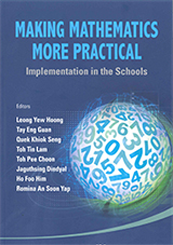Why Singapore’s English Teachers Should Embrace Singlish, Not Fight It
Is it time for Singaporean educators to embrace Singlish as a legitimate learning tool? What the Research […]
Read More
Understanding how to tackle math problems like a professional mathematician is a powerful way to get students comfortable with handling challenging problems.
To enable students to learn the process of problem-solving more effectively,
M-ProSE provides teachers with a suite of engaging and practical lessons and resources. Based on Pólya’s 4-step model of problem solving, M-ProSE ingeniously introduces math “practical” lessons into the curriculum. In these lessons, students are given interesting and challenging problems and are scaffolded to solve them using the Pólya framework.
M-ProSE has been successfully rolled out to four mainstream secondary schools, where participating students showed they could learn to apply all the steps of problem-solving. Students’ performance in the problem-solving module was also significantly correlated with their score on their school mathematics achievement test.
M-ProSE helps bring the explicit teaching and learning of problem-solving skills into classrooms by introducing math “practical” lessons based on Pólya’s model of problem solving.
In these math practical lessons, analogous to science practicals, teachers encourage learners to go through the entire mathematical problem-solving process. This is facilitated by a specially designed practical worksheet, together with an assessment rubric, that highlights each step of the process.
The problem-solving approach draws out students’ ability to think about math problems in both logical and imaginative ways. The process of solving is prioritised, instead of mere drill and practice often seen in classrooms.
Pólya’s model is a 4-step problem-solving approach that scaffolds students through the problem-solving process.
Stage 1: Understand the problem – Does your student understand the question? Is there enough information to enable your student to find a solution?
Stage 2: Devise a plan – What methods can your student use? Diagrams? Formulas? Drawings?
Stage 3: Carry out the plan – Students implement the chosen methods to solve the question.
Stage 4: Check and expand – Did your student manage to solve the question? If not, what went wrong? What worked? What didn’t?
An assessment rubric to accompany the use of the worksheets, to help teachers and students to understand the important steps in attempting to solve a mathematical problem.
Stage 4: Checking and Expanding is within the reach of the general student population.
For educators interested in understanding and implementing M-ProSE, these titles serve as ideal handbooks:
Toh, T. L., Quek, K. S., Leong, Y. H., Dindyal, J., Tay, E. G. (2011). Making Mathematics Practical: An Approach to Problem Solving. Singapore: World Scientific [Amazon]

Leong, Y. H., Tay, E. G., Quek, K. S., Toh, T. L., Toh, P. C., Dindyal, J., . . . Yap, R. A. S. (2014). Making mathematics more practical: Implementation in the schools. Singapore: World Scientific. [Amazon]
The following projects are associated with M-ProSE research:
To learn more about M-ProSE, please contact the Principal Investigator A/P Toh Tin Lam at tinlam.toh@nie.edu.sg.
Principal Investigator
A/P TOH Tin Lam, Mathematics and Mathematics Education (MME), NIE
This research on M-ProSE was funded by Singapore Ministry of Education (MOE) under the Education Research Funding Programme (OER 32/08 TTL & OER 22/12 TTL) and administered by National Institute of Education (NIE), Nanyang Technological University, Singapore. Any opinions, findings, and conclusions or recommendations expressed in this material are those of the author(s) and do not necessarily reflect the views of the Singapore MOE and NIE.
This knowledge resource was written by Ms Tan Minying, Ms Bernadine W. Sengalrayan and Ms Tan Giam Hwee in June 2017; updated by Ms Monica Lim and Mr Jared Martens Wong on 11 January 2022.